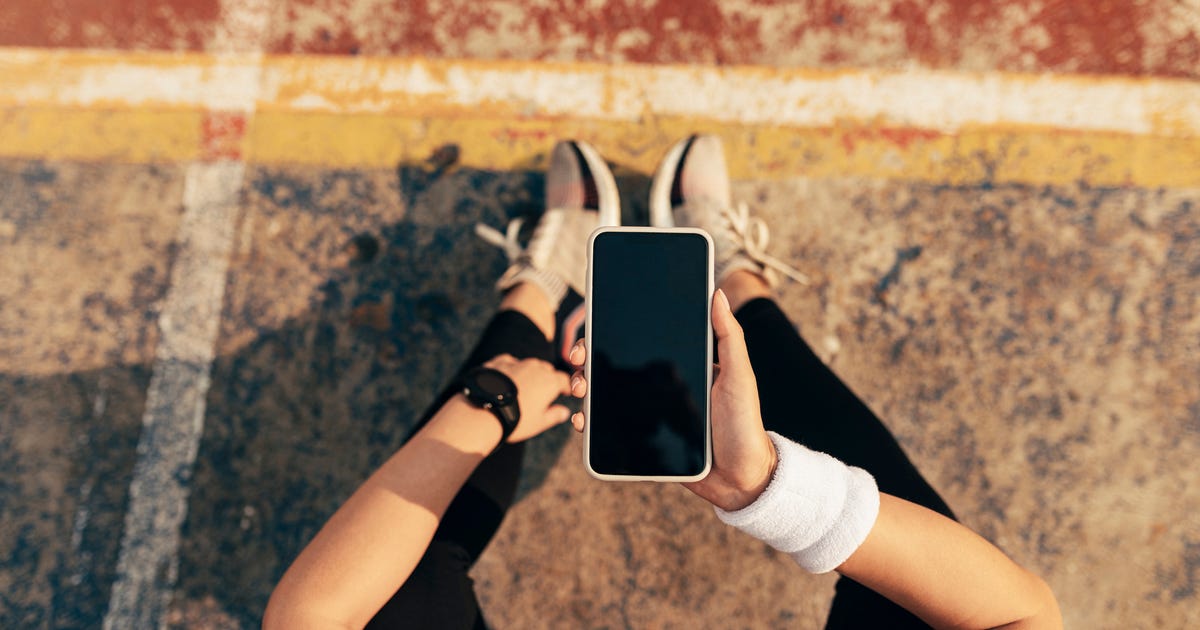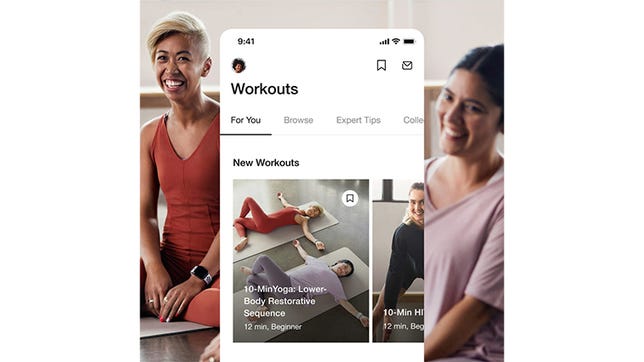The 7 Best Fitness Apps for 2023
In this article
It can be difficult to find time to go to the gym, not to mention the added cost of a gym membership making it less appealing. That’s where the best fitness apps come in. These apps deliver the perfect workout straight to your own home. And for users who prefer a hybrid workout model, you can use these programs at the gym along with all the equipment available to you.
This post-pandemic era transformed the way we approach exercise, and in some cases improved our consistency since we could do it without leaving home. For people who haven’t returned to the gym yet, it’s comforting to know that a workout is right at your fingertips.
There are hundreds of fitness apps available for both iPhone or Android. This can be overwhelming if you aren’t sure what’s best for your needs. Are you a total beginner, or a seasoned runner or yogi? Depending on what you’re looking for, different apps will work best for you.
We’ve tested and researched many of the popular available apps to determine which ones are the most useful. Some key things we took into account were:
- How easy the app is to use
- Unique features users may not get anywhere else
- The versatility of the app
- Fair price
As a former trainer and a fitness junkie who has tried various apps throughout the years, I’m aware that not all of the workouts on fitness apps are one-size-fits-all, and it’s important to be user-inclusive.
Conveniently, many of these apps offer free trials first. That way you can give them a fair shake and decide if you plan on committing. Use our list of the best fitness apps as a guide both at home and/or in the gym.
When I first started working out regularly, Nike Training Club was my go-to app. It provides various workout programs such as bodyweight exercises, high-intensity interval training (HIIT), cross-training, yoga, core exercises and even expert health tips by Nike trainers to keep you on track.
The workouts are easy to follow because there are video demonstrations of each exercise with the allotted time you should be doing them. This keeps you from losing track during your workout and mentally prepares you for the following exercise. The app also connects to your Apple watch to provide health metrics such as your heart rate and logs your activities.
The best part of this app is that it’s free and gives you access to many resources no matter if you’re a beginner or more advanced.
Pros
- Variety of classes to pick from
- Nike is a trusted and familiar brand
- Can be used at the gym or at home
Cons
- Lacks personalization
- If you don’t own an Apple watch you can’t keep track of fitness data
- Programming lacks structure which doesn’t help if you have strength goals in mind

Future
The Future app is unique because it connects you to an elite personal fitness coach who checks in regularly, gives you feedback and customizes the workout for you. They take into account your fitness level, goals and even what equipment is available to you. The creators of the app believe that connection is the best way to stick to your goals. That’s why they set you up with a partner who can hold you accountable.
To get started on this app, you have to take a short quiz about the type of workouts you like or dislike, what type of coach you work best with and your goals. There are plenty of coaches on this app with various years of experience in their respective fields. Currently, only Apple users can use this app, but developers are working on giving Android users access as well.
To get the most out of the experience, users are recommended to wear an Apple Watch, which gives detailed information to your coach so they can see your progress and edit your plan as you go. If you don’t own an Apple Watch, Future lets you borrow one so you can get the full experience. At $149 a month, Future isn’t the most affordable app on the market, but compared to a standard personal training session, which can cost more than that, it’s worth the price tag. And with Future’s current promo, you can get the first month for only $19.
Pros
- Personal trainer at your fingertips
- It’s customized to help reach your goals
- Regular check-ins with trainer without leaving home
Cons
- Pricier compared to other fitness apps
- Only available to Apple users
- You need an Apple watch, but can’t keep the loaner provided by Future

Screenshot by Mercey Livingston/CNET
There’s no doubt that the Peloton indoor cycling bike exploded in popularity over the pandemic. The digital app, which is available to non-Peloton owners, gives users access to Peloton’s library of on-demand workouts, from cycling, running and strength training to yoga, pilates and stretching. My husband and I use this app regularly, and love that it has options to do shorter or longer workouts, as well as beginner and advanced classes.
The difference between the all-access membership available to Peloton owners and the digital app is that the former allows multiple member profiles, access to exclusive classes and better access to the Leadership board (where you can compete against other users). However, it’s helpful to know that the digital app doesn’t leave out others who may want to see what Peloton is all about. If you’re not a fully converted Peloton junkie, the app is a good stepping stone to see what the hype is and whether you enjoy the classes.
The price doesn’t hurt either. The first month is usually a free trial and then it’s $13 a month with access to thousands of on-demand and live classes via your smartphone, tablet, TV or web browser. If you’re interested, you’ll want to jump on the Peloton app’s current deal which is offering the first two months free.
Pros
- Peloton is a trusted and popular brand
- Trainers are high-energy and motivational
- First month is free to test out before committing
- Can be streamed on your smartphone, TV, tablet or computer
Cons
- Lacks personalization
- If you want to appear on a cycling class leaderboard, you have to own a Peloton bike
- There’s a $32 price point difference between the all-access and Peloton digital membership if you wanted to upgrade

Strava
If you’re looking for an app that tracks your running mileage, the Strava app is your best bet. As an avid runner who’s tried various running apps throughout the years, the Strava app remains my favorite. Although I mainly use it for running, it can interchangeably be used for cycling and other workouts as well. The app is GPS powered and turns any Apple or Android phone into a detailed performance monitor. It connects to heart rate monitors and various popular GPS devices, such as an Apple Watch, Garmin, Fitbit or a Suunto watch.
It also connects you to friends on the app who can cheer you on or comment on your posts that get uploaded to your Strava feed after your workout. If you prefer to keep your data and running routes private, you can also make those changes through your settings via the app. One of the newer safety features on the Strava app is called the Beacon, which lets you share your location in real time with an emergency contact.
I’ve found the free version of the app to be sufficient for my purposes, but you can upgrade it to receive more detailed data and other perks, such as building your own routes, accessing new routes in your area and more. The paid version of the app will run you $8 a month (or $60 a year). Right now Strava is offering a free 60-day trial to users who want to try out their upgraded features before making the commitment.
Pros
- Free running app
- It lets you customize privacy settings for runner’s safety
- Connect with other runners and friends
- Can be connected to many GPS devices
- It can be used to track cycling, running, walking, walking, water sports and many other activities.
Cons
- It can lose signal depending on where you are
- There can be discrepancies between your GPS watch and Strava app data
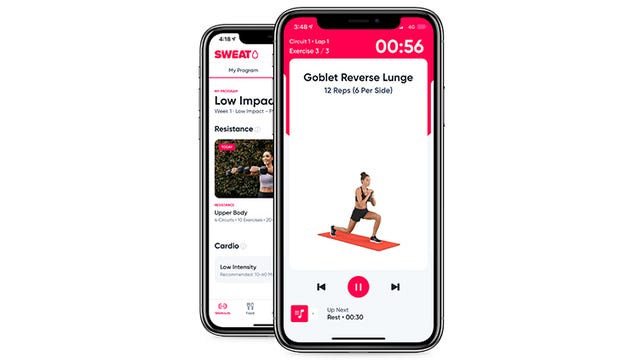
Sweat
This app was co-founded by popular Australian personal trainer, Kayla Itsines. It was created with women in mind and at the time it served as a platform to access Itsines’ HIIT workout plans, but it has since evolved. In 2021, Sweat was acquired by iFit (an interactive global health and fitness technology company), giving the app more exposure via its existing members and internationally.
Now you have access to various workout programs that can be done at home or in the gym, such as yoga, strength and pilates, all taught by different female personal trainers. The app also offers meal plan options if you’re looking for healthy recipe ideas.
This app costs $20 a month, but is currently offering a deal of $1 per month for three months. This is a good way to determine if the workouts on the app are the right fit for you and your goals.
Pros
- Various workouts to pick from that are women-friendly
- Online community is active and connects you to women around the world
- Inexpensive compared to other fitness apps
Cons
- Warm ups are optional, which can be an injury risk
- App doesn’t have ability to correct form or exercise technique
- Meal plan offered through app is not customized to your needs
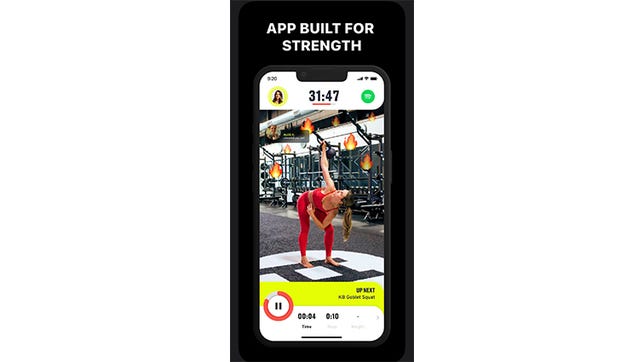
Ladder
If you’re worried about how to maintain your gains outside of the gym, then you’ll love the Ladder app. Ladder is specifically designed for strength training and connects you to many strength coaches who specialize in various fields. To find the coach that’s the best fit for you, you will have to answer questions such as your preferred training style, what your goals are, how often you’d want to workout and the type of equipment available to you. Ladder takes the guesswork out of planning your workout because the coach for your designated program will provide a weekly workout plan that you receive Sunday nights to prepare you for the week ahead.
Currently, the app only works with Apple mobile or iPad devices, and can be used with an Apple Watch or casted on a TV screen using Apple Airplay or Screen Mirroring. However, the developers are working on creating an Android compatible app.
When I tried this app out, I signed up for a kettlebell class called Body & Bell and what’s great is you get video demonstrations for the different exercises you’ll be doing. The videos also tell you the type of weight you should be using (light, medium, heavy) and the length of time of the exercise.
You can also connect with your coach via the chat in the app if you ever have questions on your training or want to chat with other members on your team. Ladder offers a free seven-day trial and afterward you can pick from a Pro plan for $30 a month or the Elite plan for $45 a month. The difference between these two is that the Elite plan gives you one-on-one coach help, which helps if you need a form check. If you’re a Ladder devotee, the app also has an option to upgrade for an extra $15 a month so you can have access to both the Pro and Elite plans.
Pros
- You can connect with a coach that’s the right for your goals
- Community is well-connected and you can ask your coach questions through the app
- Free week offered upon downloading app
- Option of one-on-one coaching for less than $50 a month
Cons
- It’s only available to Apple users
- It’s more strength training focused, so it’s not for a cardio junkie
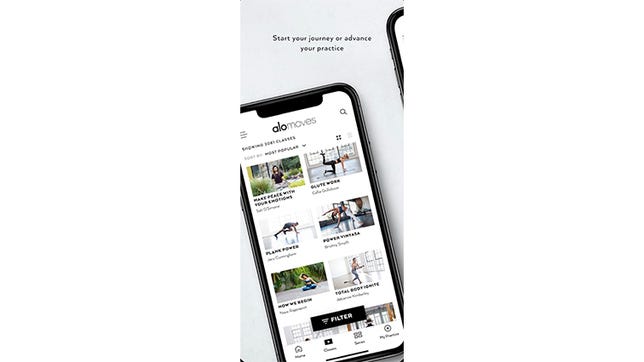
Alo Moves
If yoga is more your speed, the Alo Moves app is a favorite among yogis. The Alo Moves app was created by the athleisure line, Alo, and it connects you to various types of workouts beyond yoga, such as pilates, barre, meditation and more. The yoga option on the app lets you pick from various practices, including hatha, ashtanga, vinyasa, restorative and even prenatal yoga. You can customize your yoga practice also based on your experience level, your goals and how long you’d like your sessions to be.
This app is accessible to both Apple and Android users and connects you to world-class instructors and new classes every week. If you’re trying to achieve a specific skill, such as a handstand or other yoga poses, the app also has a series to help you improve those positions.
If you’re ready to dive into improving your flexibility or mastering crow’s pose, the Alo Moves app is currently offering a free trial for 14 days. If you choose to commit, it’s $20 a month or $199 for the year.
Pros
- Various types of yoga classes
- Free trial for two weeks before committing
- You can save and download workouts to revisit later
Cons
- Not ideal if you’re looking to gain muscle
- Pricey app for the year, unless all you’re doing is yoga
- No live classes which means you can’t interact with your favorite instructor
How we picked
- Ease of use: We found these apps to be user-friendly and easy to follow classes and the menu.
- Versatility: We looked at the variety of classes offered within the app to keep your exercise routine interesting.
- Price point: We know that most of these apps vary in price, but made sure there was a mix of cheaper and pricier apps to fit your budget.
- Programs: We looked at the programs to make sure there’s something for beginners, intermediate and more experienced users.
Factors to consider
- Decide where you will be mainly using the app — at home or the gym?
- A budget on how much you’re willing to spend monthly on a workout app
- Determine if you’ll need to have fitness equipment at home
- Decide if you want an app to get you moving or to help you achieve specific fitness goals
Fitness and workout app FAQs
What is the best free fitness app?
The best free fitness app depends on what you’re going to be using it for. Nike Training Club offers a variety of classes, whereas an app like Strava is ideal if you’d like to keep metrics on your outdoor adventures. A good place to start is by searching your App store and seeing what free fitness apps it has to offer.
What is the best fitness app for iPhones?
iPhones have many fan favorite fitness apps to pick from which include many on this list like Peloton, Nike Training Club and Strava.
How much do fitness and workout apps cost?
Fitness and workout app prices vary. Some are free or offer free trials for a week or month, which lets you test out the app before officially committing to it. Others can cost less than $10, under $50 or as much as $100 a month, depending on how personalized the experience tends to be.
Can you do personal training through workout apps?
Yes, with newer fitness apps, such as Future, you can get connected to a personal trainer through an app. It will cost more compared to other apps, but will be cheaper than a standard personal training session at the gym.
Do fitness and workout apps really work?
This depends on your goals and how consistent you are with a workout routine. Fitness apps make it easier to workout anywhere, with or without equipment and they take the guesswork out for you.
The information contained in this article is for educational and informational purposes only and is not intended as health or medical advice. Always consult a physician or other qualified health provider regarding any questions you may have about a medical condition or health objectives.
For all the latest world News Click Here

